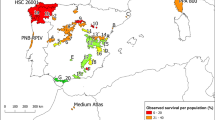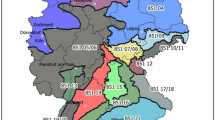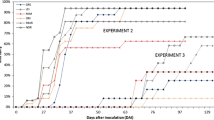Abstract
Pinewood nematode (PWN), Bursaphelenchus xylophilus, the causal agent of pine wilt disease (PWD), was detected in Spain in 2008. This gives rise to serious concern, as the disease has caused severe environmental and economic losses in Portugal and in Asian countries. We studied interspecific variation in susceptibility to pine wilt disease and differences in constitutive chemical compounds in the xylem tissue of the seven pine species -P. canariensis, P. halepensis, P. pinaster, P. pinea, P. sylvestris, P. radiata and P. taeda. Two-year-old trees were inoculated with B. xylophilus. Water potential and nematode densities were measured for each species on specific dates; whereas, wilting symptoms were recorded weekly until the end of the assay. Chemical compounds in the xylem were determined prior to inoculation. Three different resistance groups can be established in terms of the pine species susceptibility to PWN: non- to slightly-susceptible (P. canariensis, P. halepensis, P. taeda and P. pinea), susceptible (P. pinaster and P. radiata), and highly-susceptible (P. sylvestris). Nematodes migrated downward to the roots in all seven species. Constitutive xylem nitrogen, total polyphenols, and marginally phosphorus were negatively correlated with mortality caused by PWN. The most susceptible species, Pinus sylvestris, presented high levels of constitutive lipid-soluble substances and low levels of manganese, pointing to a possible relation between these components and PWN susceptibility. The results suggest P. sylvestris, P. pinaster and P. radiata forests could be severely damaged by PWN in Spain and highlight how constitutive chemical compounds such as nitrogen might play a role in resistance mechanisms against PWN.




Similar content being viewed by others
References
A.O.A.C. (1975). Phosphorus in plants. In K. Helrich (Ed.), Official methods of analysis (p. 3061). Arlington: Association of Official Analytical Chemists, Inc..
Abelleira, A., Picoaga, A., Mansilla, J. P., & Aguin, O. (2011). Detection of Bursaphelenchus xylophilus, causal agent of pine wilt disease on Pinus pinaster in northwestern Spain. Plant Disease, 95(6), 776. https://doi.org/10.1094/PDIS-12-10-0902.
Abelleira, A., Picoaga, A., Mansilla, J. P., Mosquera, P., Díaz, R., & Toval, G. (2013). Ensayo de inoculación de distintas concentraciones de Bursaphelenchus xylophilus aislado en Galicia sobre Pinus pinaster. In G. Montero González, M. Guijarro Guzmán, & E. Al (Eds.), 6° Congreso Forestal Español. Vitoria-Gasteiz: Sociedad Española de Ciencias Forestales http://secforestales.org/publicaciones/index.php/congresos_forestales/article/view/14688/14531.
Dattnoff, L. E., Elmer, W. H., & Huber, D. M. (2007). Mineral and Plant Disease (no. L-0809). American Phytopathological society (pp. 278). Isbn: 978-0-89054-346-7.
Daub, M. (2008). Investigations on pathogenicity, invasion biology and population dynamics of the pine wood nematode Bursaphelenchus xylophilus (Steiner und Buhrer 1934) Nickle 1970 in European conifers. Julius Kuhn-Institute: PhD dissertation Rheinischen Friedrich-Wilhelms-Universität zu Bonn.
Dominguez, M. T. (1987). Influencia de nutrientes y polifenoles vegetales en la humidificación de la hojarasca de especies autóctonas e introducidas en la provincia de Huelva. Madrid: PhD dissertation Universidad autónoma.
Dordas, C. (2008). Role of nutrients in controlling plant diseases in sustainable agriculture. A review. Agronomy for Sustainable Development, 28(1), 33–46. https://doi.org/10.1051/agro:2007051.
Dropkin, V. A., Foudin, A., Kondo, E., Linit, M., Smith, M., & Robbins, K. (1981). Pinewood nematode: A threat to U.S. forests? Plant Disease, 65, 1022–1027.
EPPO. (2012). New outbreak of Bursaphelenchus xylophilus in Spain. EPPO reporting service no, 03.
EPPO. (2013). PM 7/119 (1) nematode extraction. EPPO Bulletin, 43, 471–495.
Evans, H. F., McNamara, D. G., Braasch, H., Chadoeuf, J., & Magnusson, C. (1996). Pest risk analysis (PRA) for the territories of the European Union (as PRA area) on Bursaphelenhus xylophilus and its vectors in the genus Monochamus. Bulletin OEPP/EPPO Bulletin, 26, 199–249. https://doi.org/10.1111/j.1365-2338.1996.tb00594.x.
Fukuda, K. (1997). Physiological process of the symptom development and resistance mechanism in pine wilt disease. Journal of Forest Research, 2(3), 171–181. https://doi.org/10.1007/BF02348216.
Futai, K. (2003). Abnormal metabolites in pine wood nematode-inoculated Japanese black pine. Japanese Journal of Nematology, 33(2), 45–55.
Futai, K. (2013). Pine wood nematode, Bursaphelenchus xylophilus. Annual Review of Phytopathology, 51, 61–83. https://doi.org/10.1146/annurev-phyto-081211-172910.
Futai, K., & Furuno, T. (1979). The variety of resistances among pine species to pine wood nematode, Bursaphelenchus lignicolus. Bulletin of Kyoto University of Forest, 51, 23–36.
Fuyuan, X., Minghong, G., Zhenchang, Z., & Kegong, Z. (1996). Studies on resistance of pine species and Masson pine provenances to Bursaphelenchus xylophilus and the epidemic law of the nematode in Nanjing. Forest Research (China), 9(5), 521–524.
Xunta de Galicia. (2016). RESOLUCIÓN de 6 de junio de 2016, de la Dirección General de Ganadería, Agricultura e Industrias Agroalimentarias, por la que se declara en el territorio de la Comunidad Autónoma de Galicia la presencia de un nuevo brote del organismo de cuarentena Bursaphelenchus xylophilus (Steiner et Buhrer) Nickle et al. (nematodo del pino) y se ordena comenzar las medidas para su erradicación. Diario Oficial de Galicia, 21 de Junio de 2016, núm. 117, pp 25643.
Hanawa, F., Yamada, T., & Nakashima, T. (2001). Phytoalexins from Pinus strobus bark infected with pinewood nematode, Bursaphelenchus xylophilus. Phytochemistry, 57(2), 223–228. https://doi.org/10.1016/S0031-9422(00)00514-8.
Hopf-Biziks, A., Schröder, T., & Schütz, S. (2016). The pine wood nematode, Bursaphelenchus xylophilus (Steiner & Buhrer) Nickle, and its pathogenicity to German Pinus sylvestris provenances. Journal of Plant Diseases and Protection, 123(1), 43–49. https://doi.org/10.1007/s41348-016-0005-4.
Huber, D. M., & Haneklaus, S. (2007). Managing nutrition to control plant disease. Landbauforschung Volkenrode, 57(4), 313–322.
Ichihara, Y., Fukuda, K., & Suzuki, K. (2000). Early symptom development and histological changes associated with migration of Bursaphelenchus xylophilus in seedling tissues of Pinus thunbergii. Plant Disease, 84(6), 675–680. https://doi.org/10.1094/PDIS.2000.84.6.675.
Ikeda, T. (1984). Integrated pest management of Japanese pine wilt disease. Forest Pathology, 14(7), 398–414. https://doi.org/10.1111/j.1439-0329.1984.tb01253.x.
Ikeda, T. (1996). Xylem dysfunction in Bursaphelenchus xylophilus-infected Pinus thunbergii in relation to xylem cavitation and water status. Annals of the Phytopathological Society of Japan, 62, 554–558.
Ikeda, T., Kiyohara, T., & Kusunoki, M. (1990). Change in water status of Pinus thunbergii Parl. Inoculated with species of Bursaphelenchus. Journal of Nematology, 22(1), 132–135.
Inácio, M., Nóbrega, F., Vieira, P., Bonifácio, L., Naves, P., Sousa, E., & Mota, M. (2015). First detection of Bursaphelenchus xylophilus associated with Pinus nigra in Portugal and in Europe. Forest Pathology, 45(3), 235–238. https://doi.org/10.1111/efp.12162.
Kawaguchi, E. (2006). Relationship between the anatomical characteristics of cortical resin canals and migration of Bursaphelenchus xylophilus in stem cuttings of Pinus thunbergii seedlings. Journal of the Japanese Forest Society, 88(4), 240–244.
Kuroda, H., Goto, S., Kazumi, E., & Kuroda, K. (2011). The expressed genes of Japanese red pine (Pinus densiflora) involved in the pine wilt disease severity. BMC Proceedings, 5(Suppl 7), P92. https://doi.org/10.1186/1753-6561-5-S7-P92.
Lattanzio, V., Lattanzio, V. M. T., & Cardinali, A. (2006). Role of phenolics in the resistance mechanisms of plants against fungal pathogens and insects. In: F. Imperato (Ed.), Phytochemistry: Advances in Research (pp. 24–67). Kerala: Research Signpost.
Linit, M. J. (1988). Nematode-vector relationships in the pine wilt disease system. Journal of Nematology, 20(2), 227–235.
MAGRAMA. (2012). Anuario Estadístico Forestal 2011. Madrid. http://www.magrama.gob.es/es/biodiversidad/estadisticas/forestal_anuario_2011.aspx. Accessed 13 May 2014.
Mamiya, Y. (1983). Pathology of the pine wilt disease caused by Bursaphelenchus xylophilus. Annual Review of Phytopathology, 21, 201–220. https://doi.org/10.1146/annurev.py.21.090183.001221.
Mamiya, Y. (1985). Initial pathological changes and disease development in pine trees induced by the pine wood nematode, Bursaphelenchus xylophilus. Japanese Journal of Phytopathology, 51(5), 546–555. https://doi.org/10.3186/jjphytopath.51.546.
Matsunaga, K., & Togashi, K. (2004). Among-tree difference in the inhibition of systemic dispersal of Bursaphelenchus xylophilus (Nematoda: Aphelenchoididae) by Pinus densiflora. Applied Entomology and Zoology, 39(2), 271–277. https://doi.org/10.1303/aez.2004.271.
Matsunaga, K., Maezono, H., Tamaki, S., & Togashi, K. (2011). Inhibition response of Pinus densiflora clones to Bursaphelenchus xylophilus systemic dispersal and their resistance to pine wilt disease. Nematology, 13(6), 653–659. https://doi.org/10.1163/138855410X535732.
Melakeberhan, H., Toivonen, P. M. A., Vidaver, W. E., Webster, J. M., & Dube, S. (1991). Effect of Bursaphelenchus xylophilus on the water potential and water-splitting complex of photosystem II of Pinus sylvestris seedlings. Physiological and Molecular Plant Pathology, 38(2), 83–91.
Mori, Y., Miyahara, F., Tsutsumi, Y., & Kondo, R. (2008). Relationship between resistance to pine wilt disease and the migration or proliferation of pine wood nematodes. European Journal of Plant Pathology, 122(4), 529–538. https://doi.org/10.1007/s10658-008-9321-2.
Mota, M., Braasch, H., & Bravo, M. (1999). First report of Bursaphelenchus xylophilus in Portugal and in Europe. Nematology, 1, 727–734.
Nagle, A. M., McPherson, B. A., Wood, D. L., Garbelotto, M., & Bonello, P. (2011). Relationship between field resistance to Phytophthora ramorum and constitutive phenolic chemistry of coast live oak. Forest Pathology, 41(6), 464–469. https://doi.org/10.1111/j.1439-0329.2010.00703.x.
Naves, P. M., Camacho, S., de Sousa, E. M., & Quartau, J. A. (2007a). Transmission of the pine wood nematode Bursaphelenchus xylophilus through feeding activity of Monochamus galloprovincialis (Col., Cerambycidae). Journal of Applied Entomology, 131(1), 21–25. https://doi.org/10.1111/j.1439-0418.2006.01111.x.
Naves, P. M., Camacho, S., Sousa, E., & Quartau, J. A. (2007b). Transmission of the pine wood nematode Bursaphelenchus xylophilus through oviposition activity of Monochamus galloprovincialis (Coleoptera : Cerambycidae). Entomologica Fennica, 18, 193–198.
Nunes da Silva, M., Solla, A., Sampedro, L., Zas, R., & Vasconcelos, M. W. (2015). Susceptibility to the pinewood nematode (PWN) of four pine species involved in potential range expansion across Europe. Tree Physiology, 35(9), 987–999. https://doi.org/10.1093/treephys/tpv046.
Panesar, T., & Sutherland, J. (1989). Pathogenicity of canadian isolates of the Bursaphelenchus xylophilus (pinewood nematode) to provenances of Pinus sylvestris and Pinus contorta as grown in Finland: A greenhouse study. Scandinavian Journal of Forest Research, 4(1), 549–557. https://doi.org/10.1080/02827588909382587.
Peng, S., & Jay-Allemand, C. (1991). Utilization d’antioxidants dans l’straction des tannins du noyer. Journal of Chemical Ecology, 17, 887–896.
Phrame. (2007). Development of improved pest risk analysis techniques for quarantine pests, using pinewood nematode, Bursaphelenchus xylophilus, in Portugal as a model system. European Union. http://www.forestry.gov.uk/pdf/PHRAMEJuly07.pdf/$FILE/PHRAMEJuly07.pdf. Accessed 22 June 2013.
Pimentel, C. S., Firmino, P. N., Calvão, T., Ayres, M. P., Miranda, I., & Pereira, H. (2016a). Pinewood nematode population growth in relation to pine phloem chemical composition. Plant Pathology, 66(5), 856–864. https://doi.org/10.1111/ppa.12638.
Pimentel, C. S., Gonçalves, E. V., Firmino, P. N., Calvão, T., Fonseca, L., Abrantes, I., Correia, O., & Máguas, C. (2016b). Differences in pine species constitutive and inducible defences determining the susceptibility to the pinewood nematode. Plant Pathology, 66(1), 131–139. https://doi.org/10.1111/ppa.12548.
Rice, R.W. (2007). The physiological role of minerals in the plant. In: Dattnoff, L. E.,Elmer, W. H. and Huber, D. M. (Eds.), Mineral and Plant Disease (pp. 9–29). The American Phytopathological Society. Isbn: 978-0-89054-346-7.
Robertson, L., Cobacho Arcos, S., Escuer, M., Santiago Merino, R., Esparrago, G., Abelleira, A., & Navas, A. (2011). Incidence of the pinewood nematode Bursaphelenchus xylophilus Steiner & Buhrer, 1934 (Nickle, 1970) in Spain. Nematology, 13(6), 755–757. https://doi.org/10.1163/138855411X578888.
Scalbert, A., Monties, B., & Janin, G. (1989). Tannin in wood: Comparison of different estimation methods. Journal of Agricultural and Food Chemistry, 37, 1324–1329.
Soliman, T., Mourits, M. C. M., van der Werf, W., Hengeveld, G. M., Robinet, C., & Lansink, A. G. J. M. O. (2012). Framework for modelling economic impacts of invasive species, applied to pine wood nematode in Europe. PloS One, 7(9), e45505. https://doi.org/10.1371/journal.pone.0045505.
Son, J. A., & Moon, Y. (2013). Migrations and multiplications of Bursaphelenchus xylophilus and B. mucronatus in Pinus thunbergii in relation to their pathogenicity. The Plant Pathology Journal, 29(1), 116–122. https://doi.org/10.5423/PPJ.OA.06.2012.0091.
Sousa, E., Bravo, M. A., Pires, J., Naves, P., Penas, A. C., Bonifácio, L., & Mota, M. (2001). Bursaphelenchus xylophilus (Nematoda; Aphelenchoididae) associated with Monochamus galloprovincialis (Coleoptera; Cerambycidae) in Portugal. Nematology, 3(1), 89–91. https://doi.org/10.1163/156854101300106937.
Stamps, W. T., & Linit, M. J. (1988). Neutral storage lipid and exit behavior of Bursaphelenchus xylophilus fourth-stage dispersal juveniles from their beetle vectors. Journal of Nematology, 30(2), 255–261.
Suga, T., Ohta, S., Munesada, K., Ide, N., Kurokawa, M., Shimizu, M., & Ohta, E. (1993). Endogenous pine wood nematicidal substances in pines, Pinus massoniana. P. strobus and P. palustris. Phytochemistry, 33(6), 1395–1401. https://doi.org/10.1016/0031-9422(93)85098-C.
Suzuki, K. (2002). Pine wilt disease-a threat to pine forest in Europe. Dendrobiology, 48, 71–74.
Thompson, I. A., & Huber, D. M. 2007. Manganese in plant disease. In: Dattnoff, L. E., Elmer, W. H. and Huber, D. M. (Eds.), Mineral and Plant Disease (pp. 139–154). The American Phytopathological Society. Isbn: 978-0-89054-346-7.
Utsuzawa, S., Fukuda, K., & Sakaue, D. (2005). Use of magnetic resonance microscopy for the nondestructive observation of xylem cavitation caused by pine wilt disease. Phytopathology, 95(7), 737–743. https://doi.org/10.1094/PHYTO-95-0737.
Vicente, C., Espada, M., Vieira, P., & Mota, M. (2011). Pine wilt disease: A threat to European forestry. European Journal of Plant Pathology, 133(1), 89–99. https://doi.org/10.1007/s10658-011-9924-x.
Woo, K.-S., Lee, D.-H., Koo, Y.-B., & Yeo, J.-K. (2008). Inoculation of seven pine species or hybrid seedlings with Korean isolates of pinewood nematode under greenhouse conditions. Annals of Forest Science, 65(8), 811–811. https://doi.org/10.1051/forest:2008072.
Yamada, T., & Ito, S. (1993). Chemical defense responses of wilt-resistant pine species, Pinus strobus and P. taeda, against Bursaphelenchus xylophilus infection. Japanese Journal of Phytopathology, 59(6), 666–672. https://doi.org/10.3186/jjphytopath.59.666.
Yamada, T., Hanawa, F., Nakashima, T., & Ito, S. (1998). Phytoalexins accumulation in Pinus strobus following the pinewood nematode infection. In K. Futai, K. Togashi, & T. Ikeda (Eds.), Sustainability of pine forests in relation to pine wilt and decline (pp. 118–123). Tokyo: Shokado.
Yildirim, H., & Holmbom, B. (1977). Unsaponifiable, nonvolatile, nonpolar components in Pinus sylvestris and Pinus nigra. Acta Academiae Aboensis, ser. B, 37(3), 1–9.
Zamora, P., Rodríguez, V., Renedo, F., Sanz, A. V., Domínguez, J. C., Pérez-Escolar, G., et al. (2015). First report of Bursaphelenchus xylophilus causing pine wilt disease on Pinus radiata in Spain. Plant Disease, 99(10), 1449–1449. https://doi.org/10.1094/PDIS-03-15-0252-PDN.
Zas, R., Moreira, X., Ramos, M., Lima, M. R. M., Nunes da Silva, M., Solla, A., et al. (2015). Intraspecific variation of anatomical and chemical defensive traits in maritime pine (Pinus pinaster) as factors in susceptibility to the pinewood nematode (Bursaphelenchus xylophilus). Trees, 29(3), 663–673. https://doi.org/10.1007/s00468-014-1143-6.
Zimerman-Lax, N., Shenker, M., Tamir-Ariel, D., Perl-Treves, R., & Burdman, S. (2015). Effects of nitrogen nutrition on disease development caused by Acidovorax citrulli on melon foliage. European Journal of Plant Pathology, 145(1), 125–137. https://doi.org/10.1007/s10658-015-082.
Acknowledgements
We thank Ricardo Ferradás, Maribel Juncal, Belén Aramburu and Francis Ignacio for their technical assistance.
Funding
This work has been supported by the research project RTA 2010–00036-C02–01 from the National Institute for Agricultural and Food Research and Technology (INIA) and co-funded by FEDER, the Plan de Mejora e Innovación Forestal de Galicia (2010–2020) and INDITEX. This work was also co-financed by the INIA and European Social Fund (via a grant awarded to Dr. E. Jiménez).
Author information
Authors and Affiliations
Corresponding author
Ethics declarations
The authors declare that they have no conflict of interest and that the manuscript complies with the ethical standards of the journal.
Electronic supplementary material
Online resource 1
Predawn (WPp) and Midday (WPm) water potential (WP) values for Bursaphelenchus xylophilus inoculated and control trees (A: Pinus pinea, C: P. canariensis, H: P. halepensis, P: P. pinaster, R: P. radiata, S: P. sylvestris T: P. taeda.). Control trees are indicated by a lowercase “c”. (DOCX 67222 kb)
Rights and permissions
About this article
Cite this article
Menéndez-Gutiérrez, M., Alonso, M., Jiménez, E. et al. Interspecific variation of constitutive chemical compounds in Pinus spp. xylem and susceptibility to pinewood nematode (Bursaphelenchus xylophilus). Eur J Plant Pathol 150, 939–953 (2018). https://doi.org/10.1007/s10658-017-1334-2
Accepted:
Published:
Issue Date:
DOI: https://doi.org/10.1007/s10658-017-1334-2




